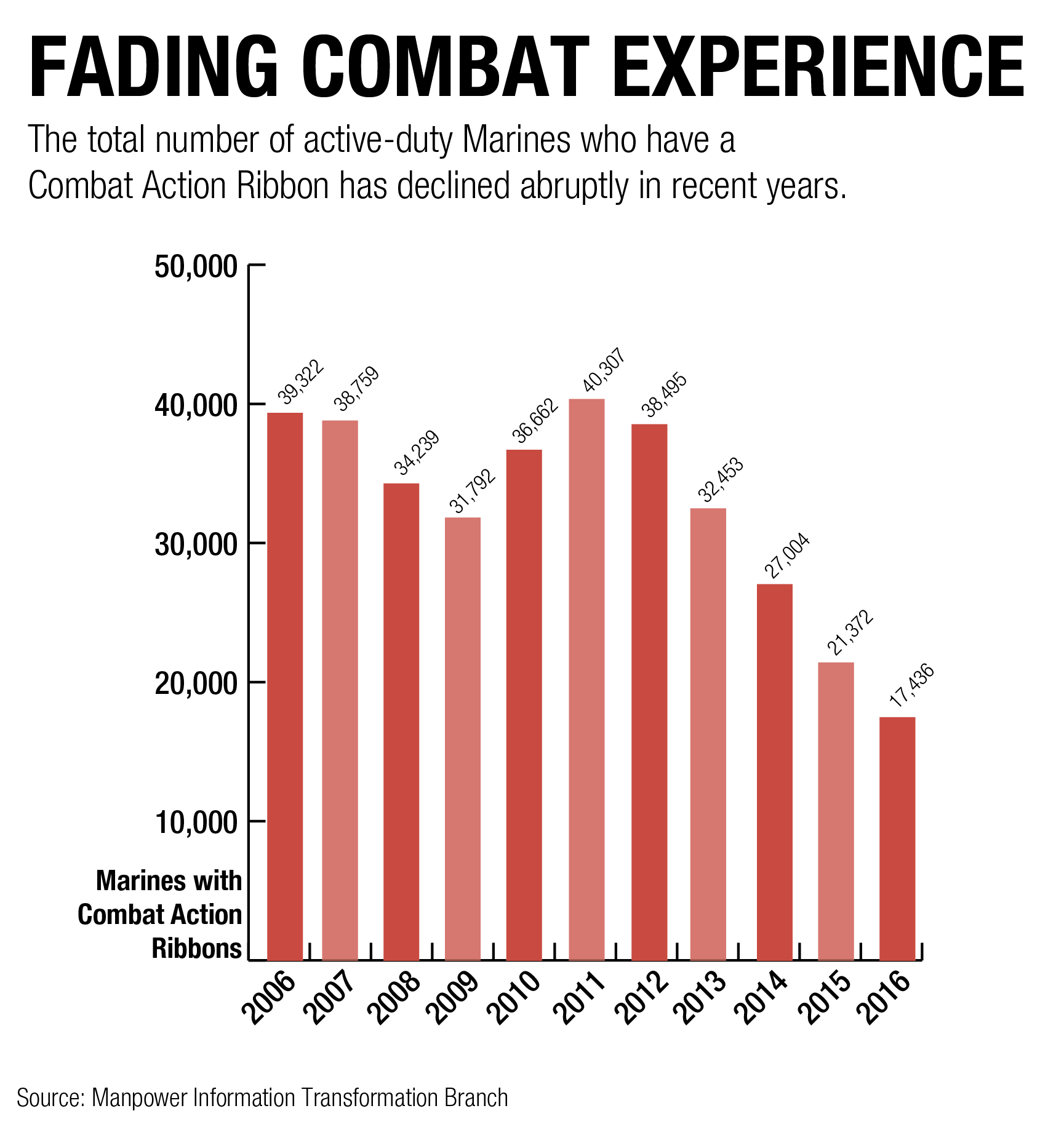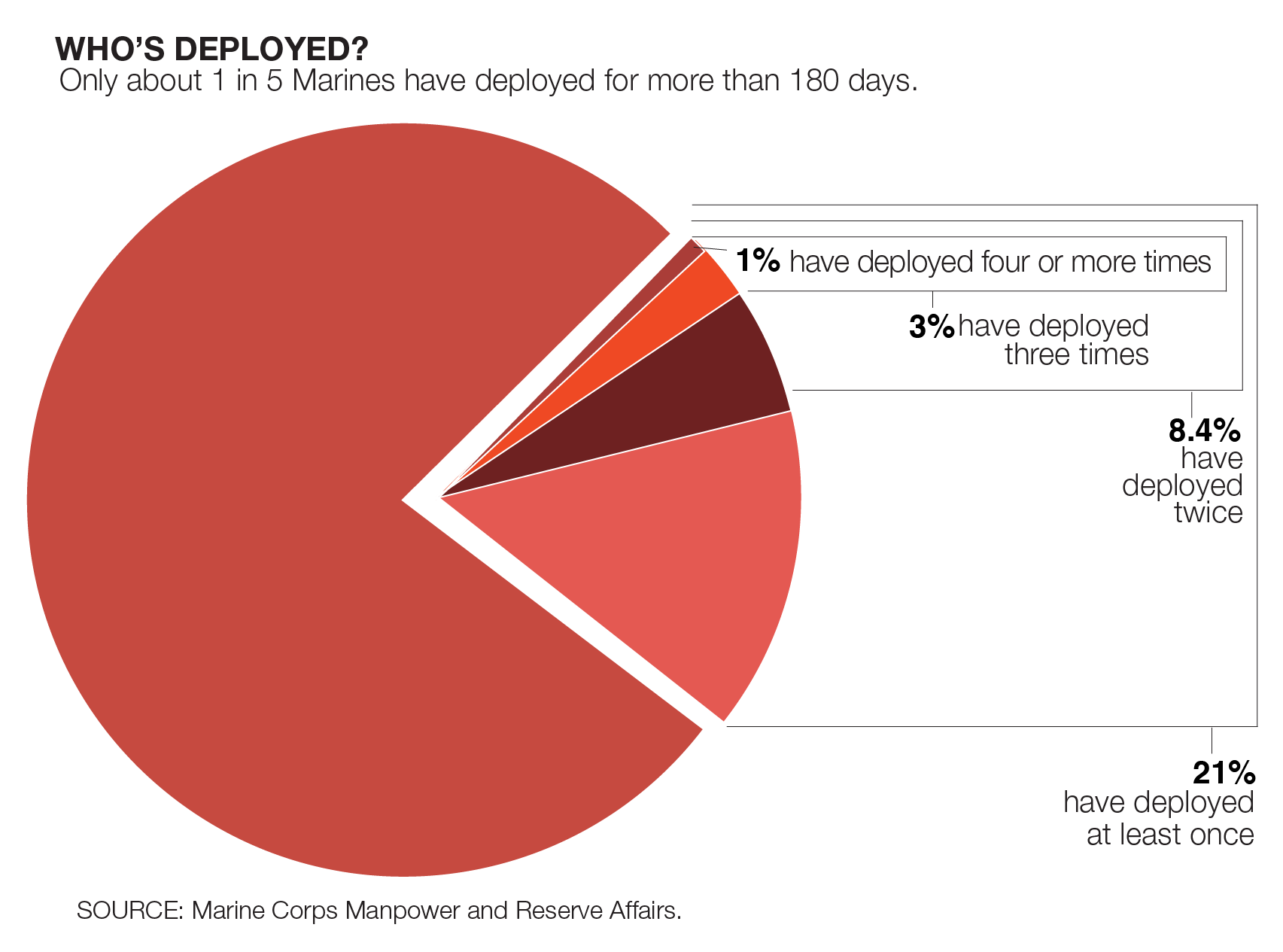The Marine Corps is facing a troubling drain of combat experience as thousands of battle-hardened Marines have left the Corps during the past several years.
The number of Marines on active-duty who have been awarded Combat Action Ribbons has dropped by more than half over the past five years — from a high of more than 40,000 at the time of the surge in Afghanistan in 2011 to fewer than 17,500 in 2016 — according to data obtained by Marine Corps Times through a Freedom of Information Act request.
In today’s Corps, fewer than one in five Marines has a single deployment under their belt and the number of Marines who have deployed twice is now less than one in 10, according to Marine Corps officials.
The shift reflects in part the Corps’ natural turnover and the reduction in combat deployments around the world. Since the U.S. drew down its troop presence in Iraq in 2011 and Afghanistan in 2014, Marines have had fewer opportunities for combat.
“Time is the biggest contributor to the loss of combat experience — because you can’t stop time,” said Sgt. Major Troy Black, the senior enlisted leader for Manpower and Reserve Affairs. “There’s no way to get around that, other than to have more combat occur.”
Yet the decline also reveals some challenges the Corps is facing in retaining those older, more combat-experienced Marines in the upper ranks. Marine Commandant Gen. Robert Neller told Congress in June that it is getting harder to retain “experienced middle management.”
That’s why the Corps has ramped up a slew of retention bonuses next fiscal year to retain high quality Marines. Combat experience is one aspect of being a high-quality Marine, along with proficiency, conduct marks and leadership skills.
The drain of firsthand combat experience is putting added pressure on the dwindling cadre of senior noncommissioned officers who can mentor today’s younger Marines and share hard-won battlefield lessons.
For example, Gunnery Sgt. Daniel Robert has had six combat deployments, including both to Iraq and Afghanistan. One of those was to Sangin, Afghanistan, in 2010 and 2011 with 3rd Battalion, 5th Marines when the unit had more casualties than any Marine unit in the Afghanistan war.
Today, Robert talks frequently with junior Marines about his back-to-back combat deployments.

“The experience I have gained on my combat deployments as a junior Marine has given me all the tools needed to succeed as I grew older in the Corps,” said Robert, the 2017 Marine Corps Times Marine of the Year.
While the loss of combat vets in the ranks is an inevitable byproduct of wars winding down, the Marine Corps still needs to be prepared to respond to ongoing threats, he said.
“This simply means we as leaders must continue to train the newer generation even harder than what we did when the war was active. As we all know, someday we will be on a battlefield in some country in this world and all must be trained to succeed regardless of the rank or jobs we’re in,” Robert said.
‘They want to deploy’
For years, the frequency and intensity of the Corps’ combat deployments was precisely what drew in Marines and kept them professionally fulfilled. Now that there are fewer traditional ground combat deployments, some Marines are leaving.
“Some came during the fight just to fight,” Sergeant Major of the Marine Corps Ronald Green told Marine Corps Times in a recent interview.
“Now that the fight is over, they say: ‘Hey, you know what? It was good while we were doing what I came to do. We’re no longer doing that. Don’t know when we’re going to do it again, so I am going to do something different.’ That’s expected of some.”
Yet Green also said the Marine Corps is not idly sitting in garrison. Marines continue to deploy as part of Marine Expeditionary Units, Special Purpose Marine Air-Ground Task Forces and rotational training forces.
“We have 38,000-plus Marines that are deployed right now,” Green said. “So I don’t want anybody to ever think that we’re not deploying Marines. We can’t get enough of them out there. They want to deploy. That’s what Marines want to do.”
Black cautioned about gauging the level of combat experience by the number of Marines with Combat Action Ribbons, which he said is “completely the wrong metric to use.”
The ribbon is awarded to individual Marines who have engaged the enemy or faced hostile fire from enemy forces. Not all Marines who go to combat receive the Combat Action Ribbon, said Black, whose wife, a retired first sergeant, has been to combat but does not have the award.
“What would probably be a better metric to use is the number of Marines who have had deployments,” Black said. “Because a deployment on a Special MAGTF right now is gaining experience — so is a MEU. Artillerymen that we see on the news that are heavily engaged are gaining experience firing cannons in support of combat operations. Are they in combat? I don’t answer that question, but they’re gaining experience.”
According to Marine Corps data, about 46,000 of today’s active-duty and reserve Marines have deployed for at least 180 days on missions that include combat operations, humanitarian and disaster relief missions, training exercises and Marine expeditionary unit deployments. That’s about one in five Marines in the force today.

Of those Marines, 18,580 — or fewer than one in 10 Marines — have deployed twice. The number of Marines in today’s force who have deployed three times is about 6,500, and only 2,181 Marines have four or more deployments, according to Manpower and Reserve Affairs.
Black said it is difficult to offer incentives targeting Marines with combat experience and, he added, combat experience is not necessarily the best experience.
“Are we incentivizing people with combat experience? No. We’re incentivizing Marines who are high performers,” he said.
“This is a competitive environment to be retained in the Marine Corps. Because of the competitiveness, all factors are taken into consideration. Do you have combat experience? That’s a factor. Are you physically fit? That’s a factor. Are you meeting basic annual training requirements? That’s a factor. Are your proficiency and conduct marks, and your fitness reports competitive with your peers? Those are all factors.”
Passing it on
Facing the inevitable loss of combat veterans, the Marine Corps needs to make sure that those Marines who have been to war impart the lessons they’ve learned to younger Marines, said Katherine Kidder, a military personnel expert with the Center for a New American Security think tank in Washington.
“To a certain extent, the services — particularly the ground forces — have been using deployments as training experience in the last 15 years,” Kidder said.
That means the Marine Corps needs to find other ways to educate troops on the skillsets and thought processes required for combat, she said. Professionally military education helped retain institutional knowledge gained from World War I when untested U.S. troops went to war again more than 20 years later.
“The question is maybe not ‘How many people are we losing,’ but, ‘Are we still maintaining enough to create the framework where you could rapidly expand with junior forces and be able to structure it in such a way that they would be competent on the battlefield,” Kidder said.
That’s exactly what the Marine Corps has been doing for the past 16 years, Green said. He said the Marine Corps has expanded professional military education so that more Marines can take the Lance Corporal Seminar, the Corporals Courses at the unit level, the Sergeants Course and courses for staff sergeants.
“We made all of that available since the war started,” Green said. “That was one, to educate us; and secondly so that we could pass that experience from combat a lot faster.”
Retention
Retaining the best combat veterans is part of a larger retention challenge that the Corps is now facing.
One factor across the military is an improving economy that offers more opportunities for experienced service members in the civilian world.
For Marines, the top Marine general said the Corps’ retention challenges are driven in part by the intense operational tempo of training and other types of deployments, even though today’s Marines have fewer opportunities for traditional combat deployments.
The current dwell time ratio of two months at home for every month Marines spend deployed, or 2-to-1 ratio. Neller has said the Marine Corps needs to return to a dwell ratio of 1-to-3.
“That’s the long term sustainable and I think, not just for the maintenance of our gear and the training of our force, but also for our families,” Neller said at a Senate Armed Services Committee hearing.
“So, we’ve been at 1-to-2. We can continue to sustain it, but I think now we’re seeing both the effects on retention of senior career Marines and on the wear-and-tear on the gear.”
Green agreed. “We’ve found out that more seasoned or older Marines — not old as in E-9, E-8 — but staff sergeants and gunnery sergeants are choosing to get out,” Green said. “That means you’re going to promote faster. That means your leadership is going to be younger with less experience.”
In fiscal 2016, the Marine Corps retained 2 percent fewer staff sergeants and roughly 4.5 percent fewer gunnery sergeants compared to the four-year average, said Capt. Scott Steele, career force planner at Manpower and Reserve Affairs. There was no significant reduction in the number of sergeants re-enlisting.
At transition readiness seminars, Marines are given surveys asking why they left the Corps at the 12- or 14-year mark instead of retiring at 20 years, Green said.
The Defense Department’s Blended Retirement System, effective in January, is also meant to help retention by offering an incentive pay to troops whom the military services want to keep, Green said.




